We take our playing cards at face value. We know the value of each card and the combinations of each needed to win. But what does each of the card suits mean, and is there something more to the suits other than matching them up to make a flush? And what is it about playing with the Queen of Hearts, the Dead Man’s Hand, or the Ace of Spades?
Symbols and Symbolism
The symbols on a standard deck of playing cards are called ‘pips’ in western countries. Pips are easily countable symbols of similar size and shape, such as the dots on dominoes, or the suits on playing cards. The symbols on the cards we know and love today have gone through an evolution of sorts, and historians offer different opinions on the origin and meaning of each symbol.
The origins of playing card suits in Europe began in the Middle Ages, with several different varieties of symbols in use at the time. The Latin suits were cups, coins, clubs, and swords. As the word for sword is a spade in Italian, we’ve kept that word in use for the oddly-shaped spade symbol, which now looks nothing like a sword. It may resemble a gardening tool called a spade by the English and a shovel by the Americans. Perhaps the swords were merely beaten into ploughshares.
As the cards traded hands (and lands) over time, the Germanic suits appeared: roses, bells, acorns, and shields, which became hearts, bells, acorns, and leaves. The French got hold of the cards and started making their own marks on them, most of which are familiar today. They kept the hearts, but substituted diamonds for bells (apparently bells were not a girl’s best friend). The acorns became clovers, or clubs. They also left the leaves behind and settled on piques, or pikes, which morphed into spades.
Suits and Social Class
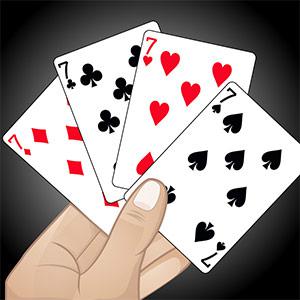
Some historians claim that the suit symbols on cards represented the 4 classes of medieval society. Cups and chalices (which later became hearts) represented the clergy. Diamonds stood for merchants, swords (spades) for nobility, and clubs for peasants.
But what about the other suits appearing on cards? The Germanic suits still in use in some countries have pikes, leaves, roses, acorns, bells, and shields. This has led certain historians to forward the notion that playing card suits had no real meaning. The artwork on cards was often elaborate, and earlier decks displayed fancy graphic designs and well-defined characters and symbols.
One explanation is that wealthy families commissioned the cards , and that the suits reflected noble tastes and interests.
Keeping it Simple
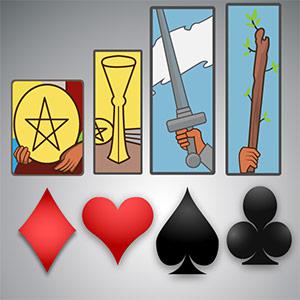
In the Middle Ages, printing techniques were simple at best (usually hand crafted), and reproducing complex graphics was difficult, and the process expensive. As card games grew in popularity, more decks of cards appeared. And some say they chose the modern suits for their simplicity. The easily recognizable and simple shapes were convenient. In addition, the cards could be quickly printed using only 2 colors—red and black. While the more elaborate decks of cards were reserved for the well-heeled, the simple 2-color, 4-suit decks were mass-produced for the masses.
In addition, many of the details of the original artwork used in creating the face cards has been duplicated so many times, that certain errors became permanently etched in playing card production. The most famous example of this type of error is the so-called ‘Suicide King.’ Originally, the king of hearts was holding his sword behind his head. But after being duplicated and reproduced so many times over time, the tip of his sword disappeared. The poor king now appears to be sticking a sword into his head.
The Face Cards
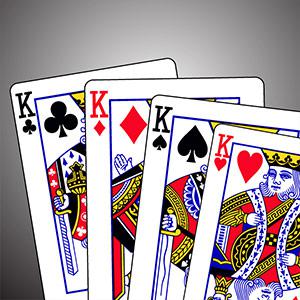
While the card suits were undergoing constant evolution, the court cards (or courtesans) depicted on the face cards have remained largely unchanged over the centuries. Kings, queens, and jacks have adorned the deck of playing cards with only minor adjustments. The kings supposedly represent the same 4 legendary kings: David, Caesar, Alexander the Great, and Charles. The queens represented Pallas, Judith, Rachel, and Argine.
Spanish decks replaced queens with mounted knights, and the Germans had the king, the ‘upper man’ and ‘lower man.’ The lower man became today’s jack. Previously referred to as a knave, the jack represents an aristocrat of the 16th or 17th century.
Jacks figure prominently in card talk; several slang terms refer to these fellows. The special hand known as blackjack consists of an ace of spades and one of the blackjacks: the jack of spades or clubs. In the early days of Vegas casinos, competing casinos would offer various payouts for special card combinations. The game of 21 was around for years, but it wasn’t until Vegas casinos offered higher payouts for getting a ‘blackjack’ 21 that the name stuck. Now, a blackjack can mean any 2-card combo that makes a natural 21. Also, ‘one-eyed jacks’ refer to the 2 jacks shown in profile (one visible eye), the jack of spades and jack of hearts.
The Almighty Ace
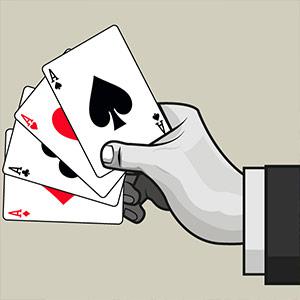
The ace is a mighty card indeed. It can be either the lowest or highest card in the deck, depending on which game you are playing. In blackjack, it can be worth 1 or 11, depending upon which number gets you closer to 21 without going over.
The ace of spades is special: 1) it bears the largest pip of the pack, and 2) Motorhead front man Lemmy wrote a song about it. But there’s a historical reason why that giant spade in the middle of the ace is larger than any of the other suits. In the 1500s, King James required the insignia of a printing house to appear on the ace of spades. This proved that the special stamp tax had been paid. It also explains why the spade on the ace is so decorative on many different decks, and why it’s the first card you see when you open the pack.
The Joker: a Fool without a Suit
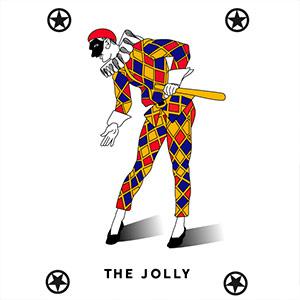
The joker playing card is unique because it is the only card in the deck without a suit. The joker appeared in the standard deck during the U.S. Civil War and used for playing the game of euchre. It was used to ‘trump’ the other cards in the deck.
The normal number of jokers in a deck of cards is 2, however, several multi-joker decks exist around the world. Since the joker never had to conform to any suits or numbers, manufacturers could depict him any way they saw fit. The joker could be a simple harlequin ‘court jester’ style or a sophisticated, well-dressed devil with a staff. The joker figure bears a resemblance to the fool in the tarot deck or the court jester of medieval lore. In the case of the latter, he is in good company among the royalty of the court cards.
Dead Man’s Hand
On August 2, 1876, legendary Old West gunslinger and poker player Wild Bill Hickok was sitting in a saloon in Deadwood, Dakota Territory, when he was shot in the back of the head by Jack McCall. He was playing a hand of 5-card stud poker at the time of his demise. That hand contained 2 pairs: aces and 8s of the black suits, clubs, and spades. Since that time, that particular poker hand is called the Dead Man’s Hand. Whether you play blackjack, poker, euchre, or bridge, the cards all bear the badges of the ages in the symbols of their suits. From the birth of playing cards through the death of legends, we have always held our card hands close to our chests, and bet to beat the odds.




